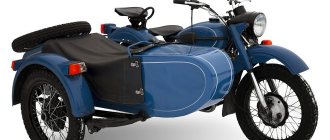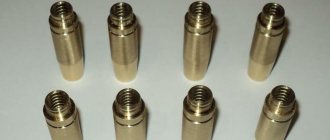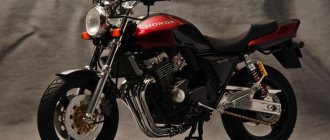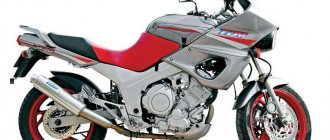Most motorcyclists sooner or later face the need for maintenance or replacement of their rear suspension.
Most often, attention is paid to this when the shock absorber begins to “punch” on uneven roads (work completely). You can check whether everything is in order with the suspension quite simply - to do this, you need to stand next to the bike, and press well on its seat closer to the rear, and then quickly release it. Normally the body of the moto will simply rise back to its original position. If it starts to wobble up and down, as if on a cushion of air, it means that somewhere something is not working correctly.
Other signs of suspension problems
An attentive motorcyclist can notice problems with shock absorbers before they start to “punch”:
- There is a feeling of instability in driving the vehicle even on flat sections of the road;
- Unsteadiness appears in turns, it is difficult to maintain the planned trajectory;
- During operation of the suspension, third-party sounds appear - from creaking or squeaking to ringing and rumble;
- The shock absorber has leaked - traces of oil remain on it (this is especially dangerous, since fluid can get into the brakes, which can cause an accident).
There can be many reasons for such changes - most often it is the age of the motorcycle. Most of the equipment driving on our roads are heavily worn “Japanese”, whose oil seals are already cracked from time and atmospheric conditions, and the springs are simply worn out. The second type of devices is the “new Chinese”, in which in most cases the quality of materials leaves much to be desired from the very beginning. Motocross and enduro motorcycles also suffer greatly for obvious reasons.
007_MOTO_0810_054
A convenient way to evaluate the range of operation of the suspension is to snap a plastic clamp onto the feather, allowing it to move freely.
A convenient way to evaluate the range of operation of the suspension is to snap a plastic clamp onto the feather, allowing it to move freely.
BRIEF GLOSSARY OF TERMS
Handling is the ability of a motorcycle to respond to driver commands. The faster and more accurate the response, the better the handling.
Stability is the ability of a motorcycle to stay on a given course and return to this course after external influences (road irregularities, wind, etc.).
Stiffness is the ability of the suspension and frame elements of a motorcycle to withstand loads that occur during movement, such as, for example, twisting of the fork during braking.
A shock absorber is an element designed to dampen vibrations in the suspension. On modern motorcycles it is always hydraulic.
The elastic element absorbs the forces arising from the action of road irregularities on the wheel, as well as dynamic changes in the motorcycle’s weight distribution during acceleration, braking and cornering. As a rule, this is a steel coil spring (but there are also springs, torsion bars, compressed gas, rubber dampers...).
Compression is the suspension stroke during which the elastic elements and shock absorbers are compressed.
Rebound is the suspension stroke during which the elastic elements and shock absorbers are released.
Spring preload is the force with which the spring is compressed in the suspension element at rest.
front fork (telescope) is the most common type of motorcycle front suspension. It consists of two stays (right and left), in which a hydraulic shock absorber and a telescopic spring are installed, and two traverses - upper and lower.
Suspension travel - the value is measured along the vertical travel of the wheel axis. However, the suspension element itself can have either more (front fork) or less (rear shock absorber) travel.
Road Bike Suspension Tuning
Air or oil shock absorber?
Before choosing a suspension replacement device, you need to understand the terminology. There are no “air” shock absorbers - there are oil (hydraulic) and gas (gas-oil, pneumatic) shock absorbers. To understand which ones are better, it is important to understand their features.
The oil suspension has low compressibility in general, and therefore absorbs surface unevenness very well, featuring smooth operation. It has both its advantages and disadvantages.
Advantages of oil shock absorbers:
- Softer operation means a more comfortable ride;
- This option is easier to produce - and therefore much cheaper;
- The oil suspension can be repaired in case of leakage.
Disadvantages of this option:
- There is air inside the device, which can “leak” over time, causing the shock absorber to lose its properties;
- During operation, the oil heats up very much, becomes more liquid, causing the suspension to become loose and can “punch”;
- If you like to ride in cold weather, remember that at low temperatures, on the contrary, the oil will become more viscous - and the shock absorber, accordingly, will be very stiff.
Gas or, as they are popularly called, air shocks have in their design a compensation chamber with gas under high pressure. They also have their advantages and disadvantages.
Advantages of air shock absorbers:
- They work more rigidly, which increases the handling of the motorcycle, especially its control in corners and on wet roads;
- Changing temperatures from high to low and vice versa has virtually no effect on the shock-absorbing function - such devices work the same in any weather;
- More durable, service life is at least a third higher.
Disadvantages of this option:
- The cost is much higher than oil ones;
- Less riding comfort;
- On “our roads” they wear out quite quickly.
 YaP didn’t bother with the cable at all - he would have taken any suitable length with similar tips and free play the same or less.
YaP didn’t bother with the cable at all - he would have taken any suitable length with similar tips and free play the same or less. There the cap of the shell is removed (more precisely, it is pulled off. I don’t care which side), the plastic shell is cut with a knife to the required length and removed. Then, with the help of pliers and wire cutters, the inner (steel) spiral is bitten off and the cap is put back in place. We have a “new” cable of the required length. All sorts of tensioners can also be adjusted using a regular hacksaw (“cut lengthwise”) By the way, I made a speedometer cable in exactly the same way (from some “Chinese moped” that happened to be in the store at that time with similar “ends” “- I bought the bike with a broken cable) and drove with it for a year until I ordered a “native” one, which turned out to be even worse than the “collective farm”.
There the cap of the shell is removed (more precisely, it is pulled off. I don’t care which side), the plastic shell is cut with a knife to the required length and removed. Then, with the help of pliers and wire cutters, the inner (steel) spiral is bitten off and the cap is put back in place. We have a “new” cable of the required length. All sorts of tensioners can also be adjusted using a regular hacksaw (“cut lengthwise”) By the way, I made a speedometer cable in exactly the same way (from some “Chinese moped” that happened to be in the store at that time with similar “ends” “- I bought the bike with a broken cable) and drove with it for a year until I ordered a “native” one, which turned out to be even worse than the “collective farm”. PS. I also know how to solder cables and spare tires; all of them are soldered from just about anything.
PS. I also know how to solder cables and spare tires; all of them are soldered from just about anything. And the clutch is now “self-made”. And it goes no worse than the “original” ones for abnormal money (yes, yes, my cables are “only from Japan”. Without options, it’s too old a waste). The only thing I'm redoing is the bosses. I make them from bronze (from old Soviet taps) or brass (bolt + file) - they are soldered much better than any of the “universal kits”. The main thing is to drill it correctly for the cable. Moreover, my “original” casings are “simple”, and I select new ones with a nylon liner inside and as a result, the cable in the casing moves easier than the “original” one. And I only go to the store for “brakes”, “oil” and “tires”. For everything else, there are hands, the Internet, an ABC book and various types of “showdowns” (like the same ebay). It turns out much cheaper. Sometimes it’s funny: an aunt on eBay sold a “hardware set” (that’s what it was written, as I understand it, “inheritance from an ex”). As a result, I received a slightly worn box, a new piston (without rings), a balancer shaft, an unlimited number of liners, bushings, bearings and seals (new ones, of course), RR, stator genes - for 10 euros. Shipping started at 16:00 I just saw it and took it, even though it wasn’t necessary at all at that time.
And the clutch is now “self-made”. And it goes no worse than the “original” ones for abnormal money (yes, yes, my cables are “only from Japan”. Without options, it’s too old a waste). The only thing I'm redoing is the bosses. I make them from bronze (from old Soviet taps) or brass (bolt + file) - they are soldered much better than any of the “universal kits”. The main thing is to drill it correctly for the cable. Moreover, my “original” casings are “simple”, and I select new ones with a nylon liner inside and as a result, the cable in the casing moves easier than the “original” one. And I only go to the store for “brakes”, “oil” and “tires”. For everything else, there are hands, the Internet, an ABC book and various types of “showdowns” (like the same ebay). It turns out much cheaper. Sometimes it’s funny: an aunt on eBay sold a “hardware set” (that’s what it was written, as I understand it, “inheritance from an ex”). As a result, I received a slightly worn box, a new piston (without rings), a balancer shaft, an unlimited number of liners, bushings, bearings and seals (new ones, of course), RR, stator genes - for 10 euros. Shipping started at 16:00 I just saw it and took it, even though it wasn’t necessary at all at that time. But something has already come in handy. The rest is lying on the balcony - he doesn’t ask to eat. And such “cases” happen there a couple of times a year - consistently. The main thing is to have time to react. - And as for the rest... The person asks how to choose... It means “off topic” that there are different(!) options. Do you want to cook? Vari (although not everything is so simple there either - overheating is not acceptable, even “local”). Do you want to install something similar? Place it. Which one is easier?
But something has already come in handy. The rest is lying on the balcony - he doesn’t ask to eat. And such “cases” happen there a couple of times a year - consistently. The main thing is to have time to react. - And as for the rest... The person asks how to choose... It means “off topic” that there are different(!) options. Do you want to cook? Vari (although not everything is so simple there either - overheating is not acceptable, even “local”). Do you want to install something similar? Place it. Which one is easier?
A few conclusions to help you make a choice
Only knowing all the advantages and disadvantages of gas-oil and oil shock absorbers can you make a choice based on your requirements for a motorcycle:
- Air ones are suitable for lovers of aggressive driving on flat roads - owners of “sports” racing on tracks;
- For bad roads and off-road conditions, it is better to choose an oil suspension, which will ensure comfortable movement;
- In any case, the new shock will be better than the old one, no matter what you purchase;
- A high-quality, expensive part will always be better than a cheap “Chinese” one.
Two shock absorbers, or a monoshock absorber at the rear?
Rear suspension debates always touch on this issue. Duo or mono - the choice affects the suspension travel, handling of the motorcycle, as well as appearance.
Fans of “classics” will always prefer two rear shock absorbers. But this design has less suspension travel, which makes it more suitable for road bikes. Owners of enduro and “tourists” choose vehicles with a monoshock absorber. It is positioned at a greater angle and closer to the engine, allowing for more suspension travel. Also, this arrangement allows you to completely eliminate any dissonance between two separate shock absorbers, which can wear out differently, which often provokes an accident.
Whatever type of suspension you choose, remember that any vehicle must be serviced on time, only then will it be comfortable and safe.
002_MOTO_0810_054_no_copyright
Remember that adjustment does not make the spring (or suspension) stiffer and is necessary to establish the correct position of the motorcycle relative to the road. However, a heavily tightened spring can poorly handle small bumps and make handling nervous. Sometimes the springs have to be changed (usually from stock to stiffer ones). The main indication for replacement is the fully usable travel of the suspension at a given initial (see above) preload. A plastic clamp placed on the fork leg (shock absorber rod) will help determine the range of suspension movement. Ride in extreme conditions (on turns, over bumps and smooth waves of asphalt, with intense braking): if, when the suspension is compressed, there is a travel reserve of 10–15 mm, the springs are optimal, if it is larger, but you are satisfied with everything, you can leave it as is, if less - it is worth installing stiffer springs.
After adjusting the springs, set the basic shock absorber settings (from the instructions). We will choose a road with various turns and irregularities. Let's drive along it several times and record our impressions. It is very important to understand what exactly you don’t like and write it down. If everything suits you, don’t waste your time looking for something unknown. It's better to do something more useful or enjoyable.
TILT ANGLE OF THE ROTARY AXIS. By changing the height of the suspension, you can significantly change the behavior of the motorcycle. By lifting the rear or lowering the front, you will reduce the angle of the front wheel's turning axis, the control will become more “sharp”, but the stability of the motorcycle may deteriorate. Changing it the other way around will produce the opposite results. What is better - lowering or raising - depends on many factors. If you are drawing the asphalt with the anchors of the pegs when turning, you should not lower the ground clearance even more. The technical ability to adjust it is also important. You cannot change the height of the motorcycle due to the preload of the springs - they set the operating range of the suspension and we have already adjusted them. You can move the fork stays slightly in the yokes (within 10–15 mm) or use spacers for the rear shock absorber mounts. However, there is usually no need to change the fork angle specified by the designers.
SHOCK ABSORBERS. The main guidelines for adjusting shock absorbers are given in the table. Let's dwell on the quick compression adjustment, which has recently appeared on production motorcycles. It allows you to adjust the operation of the shock absorber to roads with small irregularities. By releasing the adjustment screw, you allow the shock absorber to easily move a short distance and “eat up” bumps, increasing the time of good contact between the wheel and the road. In this case, the main adjustments of the shock absorber, designed to work during acceleration, braking and cornering, are not affected. On flat roads, the fast compression adjustment is usually tightened almost to the limit.
Never take adjustments to extreme values. If you see the need for this, it means that the motorcycle is not in order (for example, the oil of the wrong viscosity is filled) or it is simply not suitable for you (which is much less common). Make only one adjustment at a time. Write down everything you do, including how you felt during the test ride. If you think you've found a good combination, return the settings to the default settings and double-check that your option actually works better.
STEERING DAMPER. Some motorcycle designers say that a steering damper is needed only for those motorcycles that have an imperfect chassis design. This is not entirely true. Motorcycles designed with damper in mind from the start tend to have better handling. But it is very important to understand that it is not needed to hold the steering wheel in a fixed position, say, when forcing a deep pothole encountered in a fast turn. The damper's task is to prevent resonant vibrations that occur during driving from intensifying and developing into dangerous bumpiness. A heavily tightened damper interferes with precise motorcycle control, so experienced riders adjust it to the lowest possible stiffness.
TIRE PRESSURE. It also affects the behavior of the motorcycle, but especially the wear of the tires themselves (“Moto” No. 6–2010). In racing mode, pressure is measured after a hot race. As a guide, we can recommend 2.0–2.4 atm in the front and 1.9–2.3 in the rear.
IN THE RAIN. The general principle of rain settings is to “loose up” the suspension without allowing the wheels to suddenly lose contact with the surface. Unscrew the hydraulic adjustment screws 2-3 clicks. And if you come to the track for results, you may have to install softer springs. Remember the general rule: the stiffer the springs, the stiffer the hydraulics and vice versa.
SOME SETUP RECOMMENDATIONS
| Insufficient clearance in turns | Increase spring preload front and rear |
| When braking, the rear wheel rises sharply, the motorcycle is unstable | Reduce rear suspension spring preload |
| When braking, the front wheel suddenly locks | Increase front suspension spring preload |
| When accelerating, the motorcycle sways from side to side | Increase rear suspension spring preload |
| Steering wheel jerks when accelerating over bumps | Reduce front suspension spring preload |
| The motorcycle goes over uneven surfaces harshly and bounces | Open the rebound valve 1–2 clicks |
| Jumping when accelerating in turns, insufficient grip, tendency to “crushing” | Open the slow compression valve 1–2 clicks |
| The motorcycle sag, the suspension is heavily compressed on small bumps | Close the slow compression valve 1–2 clicks |
| The motorcycle does not listen well, behaves unstable and nervously on the rebound, and is prone to swaying. | Close the rebound valve 1–2 clicks |
| The motorcycle is unstable in fast turns, the suspension on bumps and turns is pushed all the way | Close the quick compression valve 2-3 clicks |
| Rigid, uncomfortable behavior when compressing the suspension | Open the quick compression valve 2–3 clicks |
| Front wheel chatter | Reduce fork oil level |










